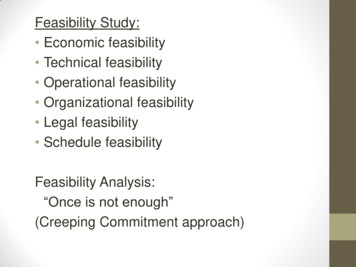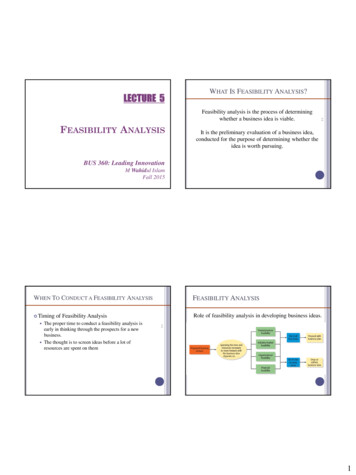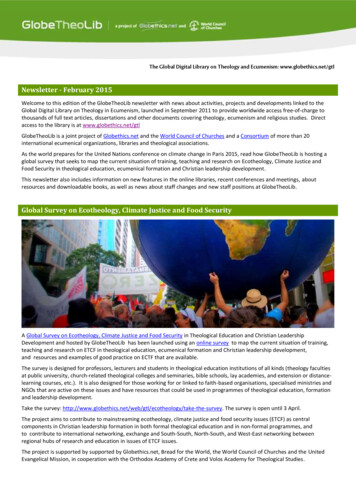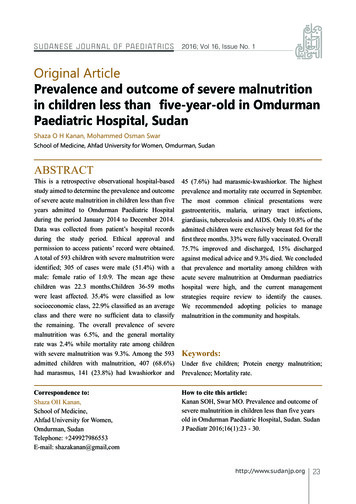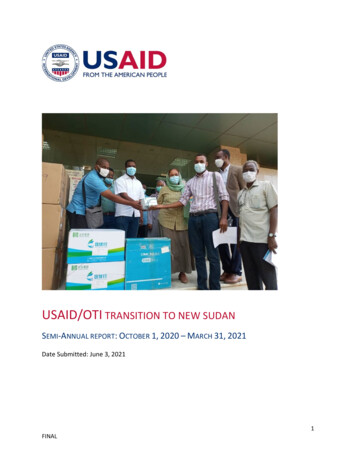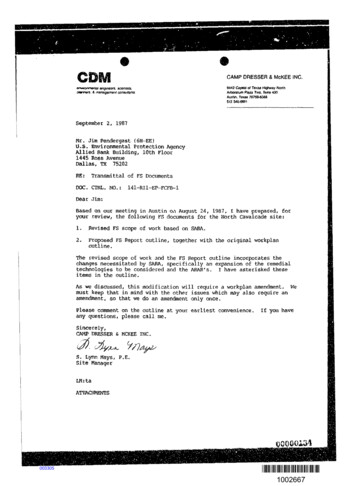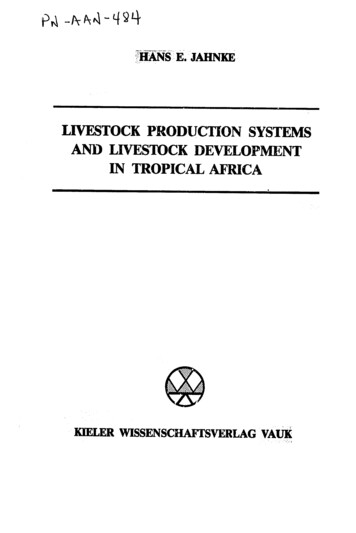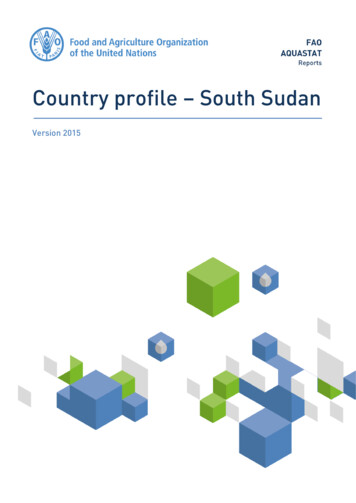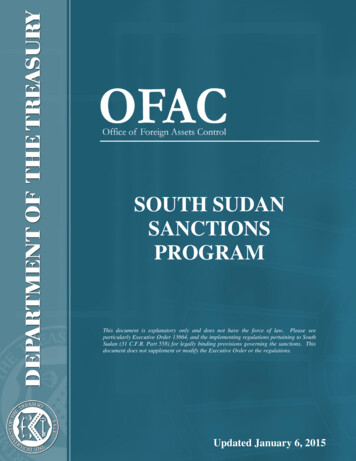
Transcription
USAID BUREAU FOR HUMANITARIANASSISTANCE (BHA) SUDANLIVESTOCK FEASIBILITY STUDY DESK RESEARCH FINDINGS & INITIALRECOMMENDATIONSMay 2022This study is made possible by the support of the American people through the United States Agency for International Development (USAID.)Its contents are the sole responsibility of SSG Advisors, LLC d/b/a Resonance and do not necessarily reflect the views of USAID or the UnitedStates Government. It was produced in collaboration with the US Global Development Lab’s Center for Transformational Partnerships and theBureau for Humanitarian Assistance.
TABLE OF CONTENTSIntroduction41.1 Context41.1.1 Purpose of the Livestock Feasibility Study41.2 Methodology51.2.2 Stakeholder Identification1.3 Limitations2. Desk Research2.1 Characterization of the Livestock Sector in Sudan56772.2 Overview of Value Chain Constraints122.3 Overview of Value Chain Opportunities132.4 Characterization of the Public Sector142.5 Overview of the Conflict Situation at the Intersection of Farmers and Pastoralists153. Interview Insights194.Trends & Partnership Opportunities for Further Exploration215. Recommendations/Next Steps236. Sources25Annex I: Sudan PSLA Contacts26Annex II: Interview Guide262
PSLARISINGSOWUNUSAID3U.S. Bureau of Humanitarian Assistance (Formerly FFP and OFDA)2019 Novel Coronavirus or 2019-nCoVGross Domestic ProductInternally Displaced PopulationsInternational Fund for Agricultural DevelopmentKey Informant InterviewsMicro, Small, and Medium-Sized EnterprisesNon-Governmental OrganizationsPromoting Excellence in Private Sector Engagement (USAID project)Private Sector EngagementPrivate Sector Landscape AssessmentRecovery in Sudan for Improved Nutrition and Growth project (USAID-funded)Scope of WorkUnited NationsUnited States Agency for International Development
Introduction1.1Context1.1.1 Purpose of the Livestock Feasibility StudyThe U.S. Bureau for Humanitarian Assistance (BHA) continues to explore opportunities toidentify, engage with, and collaborate with the private sector in high-potential, action-orientedhumanitarian assistance activities across key regions of its portfolio. In that regard, thePromoting Excellence in Private Sector Engagement (PEPSE) project recently conducted aprivate sector landscape assessment (PSLA) in Sudan, which mapped the country's privatesector landscape and identified broad private sector engagement (PSE) or partnershipopportunities. The PSLA findings revealed a strong private sector market push towardinvestment in the livestock value chains. Specifically, the PSLA team learned through itsstakeholder interviews that conglomerates are especially interested in livestock as a strategicexpansion, including research and development into the fattening process and qualityenhancement, slaughtering, and export of live animals or processed meat products. TheUSAID/BHA team in Sudan confirmed these findings through recent, follow-up conversationswith the private sector.USAID/BHA sought to build on the initial USAID/BHA Sudan PSLA to conduct a feasibilitystudy to better understand the potential role of USAID/BHA’s target beneficiaries (i.e., farmersand pastoralists) in the expansion of the Sudanese livestock sector and opportunities andmodels for partnership with the private sector. The study primarily examined cattle but alsoexplored other livestock, specifically sheep and camel value chains. The study aimed tospecifically focus on private sector partnership opportunities and market-based models that willconcurrently reduce poverty and build resilience for USAID/BHA's target beneficiaries and helpthe private sector to expand the livestock sector.The objectives of the study include: Mapping the rural livestock sector value chain for cattle, sheep, and camel in Sudan, witha focus on small-scale producers, and identifying the challenges, bottlenecks, andpotential entry points. Mapping the private sector actors (from micro-, small and medium- sized enterprises(MSMEs) enterprises to large conglomerates) interested in working within the livestocksector value chains of cattle, sheep, and camel, including their perceived barriers andneeds for entering or expanding the sector.4
Understanding the potential engagement of and necessary buy-in from the Governmentof Sudan in expanding Sudan's livestock sector, including both federal- and state-levelgovernment agencies. Identifying how the livestock sector can help reduce poverty and vulnerability forUSAID/BHA's target beneficiaries in Sudan, including farmers, pastoralists, disadvantagedwomen and youth, Internally Displaced Populations (IDPs), and host communities. Determining how best to engage USAID/BHA's target beneficiaries (i.e., farmers,pastoralists, disadvantaged women and youth, IDPs, and host communities) to expandthe livestock sector, including the best potential entry points for engagement along theentire livestock value chain. Designing a potential engagement model for USAID/BHA support to expand thelivestock sector, including the potential partners, roles, business models (e.g., farmingand service contracts), entry points, and joint outcomes. Exploring and identifying intersections between livestock sector expansion and potentialareas of conflict (e.g., the conflict between farmers and pastoralists) and ensuring thatthe Do No Harm approach/framework is used to analyze the impacts that the proposedengagement model may have on conflict.1.2Methodology1.2.1 Feasibility Study DesignThe PEPSE team and USAID/BHA co-created the focus and objectives of the feasibility studythrough an introductory kick-off meeting and subsequent conversations with USAID/BHAstakeholders based in Washington, DC and Sudan. Together, they designed the study context,objectives, implementation plan, deliverables, team composition, and timeline. USAID/BHAapproved the final PSLA Scope of Work (SOW) on July 7, 2021.1.2.2 Stakeholder IdentificationThe team identified over 60 private and non-private sector stakeholders (Annex I) fromthroughout the livestock value chain (input service provision, financing, production, marketing,processing, distribution/export) as well as the enabling environment (local and federalgovernment agencies, BHA implementing partners, NGOs and other humanitarian donors).1Mapping the stakeholders to the value chain and enabling environment functions within thelivestock system, helped to identify any gaps in stakeholder identification. From there, the team1Inputs used in the stakeholder identification included the BHA/PEPSE PLSA stakeholder list, recommendations fromUSAID/BHA, the USAID/Sudan team, and contacts derived from the team’s network and desk research.5
ranked each contact as high, medium, or low priority to identify the preferred stakeholders forKey Informant Interviews (KIIs).1.2.3 Desk ResearchThe team conducted a desk review to gather baseline information of Sudan's livestock sector,focusing on cattle, sheep, and camel value chains in the Kordofan, Darfur, and the Blue Nileareas.1.2.4 InterviewsIn conjunction with this desk research, the team conducted three remote, semi-structuredinterviews with federal government officials in Sudan as well as one in-person interview with aveterinary cooperative. These initial interviews focused on eliciting nuanced feedback and inputon the potential engagement of and necessary buy-in from the Government of Sudan inexpanding Sudan's livestock sector, including both federal- and state-level government agencies.See Annex II for the interview guides developed for each stakeholder group.1.3LimitationsDuring the study, the Prime Minister of Sudan was detained by military forces in October 2021which led to internet blockages and several rallies and demonstrations against the military coupand resulted in several deaths and injuries. The Prime Minister was reinstated at the end ofNovember, but resigned shortly afterwards in January 2022. This has left the country without afunctioning government and has led to frequent demonstrations and periodic restrictions tophone and internet access throughout the country. There have also been increased restrictionson NGOs and development actors imposed by the military in recent months2. In addition, newconflicts erupted in Darfur and Kordofan since the start of the study. The fragility of thesituation in Sudan made it impractical to proceed with the field visit or conduct furtherinterviews with NGOs, donors, or the private sector as they were either not responsive or letus know that given the current situation, they were not available for an interview.The team was only able to complete three interviews with public sector actors and onecooperative, prior to the political instability. Of the interviews the team conducted, three of thefour were done by phone, due to concerns resulting from the ongoing COVID-19 pandemic. Itis important to note that this report incorporates the aggregated opinions of a small number ofinterviewees. Together with the desk research, their insights and suggestions informed therecommendations but do not represent a complete stocktaking of the livestock sector in Sudan.The report is therefore designed to offer recommendations for next steps and initial high-levelopportunities for USAID/BHA to explore further. Additional and/or follow-up id-freeze-103024
with potential stakeholders are needed to determine whether the opportunities are viable forboth parties.2. Desk Research2.1 Characterization of the Livestock Sector in SudanSudan ranks first to third among all African countries in the number of cattle, sheep, goats, andcamels with an estimated total of 105.6 million heads (39.8 million sheep; 31 million goats; 30.1million cattle; and 4.7 million camels). It is estimated that livestock accounts for 40% oflivelihoods in Sudan and contributes around 25% to the national gross domestic product (GDP).Livestock has consistently provided more than 60% of the estimated value added to theagriculture sector GDP and is a substantially more important contributor than crop agriculture.The type of livestock also varies from region to region and, even in the same region, the type oflivestock varies from state to state. As shown in Figure 1, Greater Darfur has the largestnumber of total livestock among the three targeted regions. Sheep are the highest in number inall three targeted regions.Figure 1. Number of livestock by RegionSource: The Sudan Central Bureau of StatisticsAs shown in Figure 2, the Korodan states individually have the largest numbers of livestock ascompared to states in Darfur or Blue Nile. Among all the states, West Kordofan has the largestnumber of livestock. In Kordofan, sheep are most prevalent, other than in South Kordofanwhere there are more cattle.7
These figures have been gathered from The Sudan Central Bureau of Statistics, which are thenumbers formally recognized by the Government of Sudan. With that said, there has not been anational livestock census since 1975 (which covered the entirety of what is now Sudan andSouth Sudan). Since that time there have been a number of state level censuses whichsometimes match and sometimes deviate from official estimates by a wide margin (based onmodeling over generations). This is a significant data limitation negatively impacting public andprivate sector livestock development planning. The 2010 International Fund for AgriculturalDevelopment (IFAD) livestock census in North Kordofan has shown a measurable shift tosheep, estimating over 22 million heads of sheep in North Kordofan, as compared to the 2.4million reported by the 1975 census. This shift to sheep is also evident in South Kordofan (3.8million heads of sheep estimated).The majority of all livestock production, possibly 90%, although is difficult to determine due tothe lack of updated data, comes from smallholders and migratory producers. The Sudaneseeconomy is based on a combination of nomadic and sedentary pastoral and agro pastoralproduction by farming and herding households in almost every region and state. Althoughhouseholds engaged in agriculture have the highest rates of poverty, those that are engaged inanimal husbandry, as compared to those in crop farming, have lower rates of poverty. For manyof the landless poor, livestock are often the only assets they have and their products (milk,meat, eggs, wool) provide a direct or indirect source of income throughout the year. Livestockalso provide a means for cash in times of need and rarely depreciate in value, however they areat risk for disease and to drought and theft.Figure 2. Number of Livestock by StateSource: The Sudan Central Bureau of Statistics8
The local breeds, while adapted to the climate and the environment in the three areas, arecharacterized by low productivity in comparison with the region, especially for dairyproduction. The constant movement from one place to another makes livestock more muscularand less fattened, which reduces the quality of meat. With that said, sedentary systems rely on aquality animal feed sector (noted as a limitation in the value chain below) to produce feedelsewhere, aggregate feedback, and then supply it to concentrations of sedentary livestock. Thisis typically only viable in temperate grassland areas although opportunities exist forstratifications to include a fattening, sedentary phase as mobility is critical in optimizing grazing.In addition, there are limited veterinary services (animal health, disease control, vaccination, andveterinary extension) particularly in the three targeted regions.Cattle and camel herders migrate seasonally, starting in the south at the beginning of the rainyseason and moving north with the advancing rains (transhumance in eastern Darfur is shown inFigure 3 and throughout the targeted regions in Figure 4). They stay in the north for betterpasture and breeding conditions until the end of the rainy season or depending on availability ofwater and pastures. They then return south where there is more pasture, fodder, andpermanent water sources to sustain their livestock through the dry season. Transhumance alsoallows them to avoid the challenges that mud and flies present in the south during the rainyseason. The migration back to the south at the end of the rainy season coincides with thepost-harvest period, which allows livestock to graze on post-harvest crop residues and tofertilize farmer fields. Although it is a mutually beneficial relationship for herders and farmers,this interaction between farmers and herders during transhumance has been undermined byconflict due to changing climatic patterns, competition over natural resources (including landpressure), changes from traditional to commercialized crop farming practices, and increasingmonetary needs for production and livelihoods.The pastoralist transhumance, conflict, agricultural borders, and demarcation between land forfarming and migration were historically managed through traditional leadership. When thegovernment began allocating land for large, commercial farming areas, it became the role of thelocal or state government to regulate and formalize transhumance corridors. The allocation anddemarcation processes included stakeholders and traditional leadership dialogues, however,there might have been instances when the government (the Bashir regime) acted in favor offarming area allocation which blocked routes for pastoralists.9
Figure 3.Transhumance for cattle pastoralists in eastern DarfurSource: Feinstein International Center. “Risk, Resilience, and Pastoralist Mobility” (2016).Figure 4.Transhumance of Pastoralist PopulationsSource: IGAD Climate Atlas Sudan, retrieved from World Food Programme and Met Office, “FoodSecurity and Climate Change Assessment: Sudan (December 2016).10
Most producers sell their livestock in local weekly or seasonal markets which only offer limitedbusiness services and lack veterinary services in those regions. Large-scale pastoralists tend tosell mature livestock to traders in the larger markets along transhumance corridors andtowards the northern end of the migration cycle, where prices are better. Small herd ownerstend to sell what is on hand to meet immediate consumption needs, while richer pastoralistssell select animals from their herds to purchase younger breeding stock. The small herderowners in Darfur often sell to the closest markets to them which is usually a village market andcan be temporary/not regular. The few main markets, which smaller markets feed into, arelocated in major cities like El Obeid, West Omdurman, and Forbaranga.2.1.1 Livestock Production SystemsIn Sudan, farmers and pastoralists utilize different methods to raise livestock depending on thecommunity groups and their livelihood activities. In the first type of production system animalsare owned by pastoral groups (nomadic or semi-nomadic) where herders in Darfur andKordofan travel vast distances (400 km or more in a single year) for better pasture and breedingconditions (as described above), including crossing the border of South Sudan and othercountries like Chad and Central African Republic. This group is the most predominant andmakes up the largest contribution to the country’s GDP through their participation in thedomestic and export markets. In the second type of production system, typically referred to asthe crop-livestock system, animals are raised by sedentary farmers in the irrigated areas (mainlyaround the Nile river) or in rainfed areas and are used mainly for agriculture use, such as draftanimals, or to satisfy other household needs, such as milk. In the third type of system, animalsare raised in settled households (not nomadic) on the plains away from the irrigated areas andare used for dairy or sold in domestic markets. In the fourth type of system, animals are raisedby the rain-fed scheme owners in a mixed farming system where farming byproducts are used asfodder. This is mainly found in the following areas: Kordofan, Blue Nile, Sennar, and Gadarif.Finally, in the fifth type of system, animals are raised by the commercial sector mainly to supplynearby urban areas with milk and meat. This is found mainly around Khartoum, El Obeid, orMadani.The emphasis in this report focuses on the impact of the portion of livestock raised by pastoralethnic groups including the nomads, semi nomads, and settled community. These scenarios aremostly found in the targeted communities of Kordofan, Darfur, and Blue Nile.2.1.2 Recent Changes Impacting the SectorDuring the desk research, the team identified some recent changes impacting the livestocksector. This includes increased prices for livestock in the production areas, local/village markets,11
and the large markets in Khartoum and El Obeid, which might be driven by increases inlivestock exports and local consumption.In addition, increases in artisanal gold mining in Sudan and in the targeted areas have limited theavailable pasture land due to large mining operations and lack of access to land as well ascontamination of water sources. Mining has also attracted labor from the livestock sector andprovides much larger incomes for improved livelihoods. With increased incomes, communitieshave less of an urgency or need to sell their animals and keep them as social capital instead ofeconomic opportunity.Commercial private sector companies (and armed forces-owned companies) have increasedinterest in the sector with greater involvement in primarily exports and some local processing,however they have limited involvement with producers and the production areas and utilizeagents and middlemen to purchase livestock products. Companies owned by armed forces andother private sector firms are also making a few new investments in livestock infrastructure,mainly new slaughterhouses, quarantine facilities, fattening farms, and meat processing plants(for local consumption and export) but they are mainly located in or near Khartoum.Recent developments in rural finance such as microfinance, bank loans, cooperative finance, andcontract farming, do not specifically address the finance needs for the livestock sector. Exceptfor large livestock traders and exporters, almost none of the livestock value chain actors benefitfrom formal finance through banks or other financial institutions. Formal inclusive finance wouldimprove producer and cooperative capacity to access veterinary services, feed, water, and valueaddition activities (such as fattening or cheese making).2.2Overview of Value Chain ConstraintsThe team identified the following top constraints along the value chain: Feed: The main sources of feed for small-scale livestock raising is grazing fromrangeland and fallow land as well as house waste and crop residues. The primary issuewith this approach is that it lacks protein content to increase productivity. The availablefodder (alfalfa and sorghum) lacks enough protein and other essential nutrients forlivestock fattening. The most used protein source for other animal feed in Sudan aregroundnut cake and sesame cake which are byproducts of oil pressing. Some otherprotein sources are imported such as fish meal which is used in concentrated feed. Thecommercially-developed feed is quite difficult to obtain as commercial farmers havecontractual arrangements with these feed-producing companies and procure most of theproduced feed. The remaining concentrated feed is sold through auctions. Veterinary Services: The main issues related to veterinary services include lack ofpersonnel, technical knowledge, and capacity in remote areas to provide quality services.12
3Veterinary services are not distributed equally throughout the country as manyprofessionals do not wish to work in hash, remote, and sometimes conflict-prone areas.Sudan’s administrative and technical capacity to provide extension and veterinaryservices, especially to pastoral and agro-pastoral livestock communities, is limited andmany veterinary staff move to Gulf countries in search of better employmentopportunities and higher salaries. In addition, paraprofessionals are not effectivelyintegrated into the system and States have a limited capacity to train local people whowill return to the field for work.Financial Services: There are very few financial service providers in the traditionalrain-fed areas where livestock, dairy, and horticulture crops are produced in largequantities. The Government of Sudan annually allocates and prioritizes agriculturefinance for priority crops like sorghum, wheat, and cotton. As a result, there are fewfinancial products available for the rest of the agricultural sector or value chains.Producers, primarily smallholder farmers, are largely without access to formal credit andrely on local money lenders and village traders with high interest rates.Advisory and Extension Services: Farmer cooperatives and associations are weak,only found in a few states, and provide limited inputs and services to producers. Publicsector-led advisory and extension services are lacking and have limited outreach andirregular follow-up. The private sector advisory services are limited to contract andcommercial farmers who cultivate and supply products exclusively to select processors,such as DAL group3.Marketing: The marketing system in Sudan is complex, consisting of many small-scaleactors (pastoralists, smallholder farmers, local traders, brokers, domestic meatprocessors) and exporters from private and semi-governmental institutions. Manyplayers are involved in getting livestock from rural areas to the main market. First,pastoralists/smallholders sell the livestock to local traders at the village level. Thelivestock is then transported to larger livestock markets and are sold to brokers. Thebrokers then sell the livestock to the domestic meat processors and exporters. Theinclusion of middle men (traders and brokers) creates significant price differencesbetween local and main markets. For example, the price for sheep in production areaswas 87% of the main market price in 2015. However, due to the high demand oflivestock recently, the private sector and large traders have started to connect moredirectly at the producers level. This high demand might have also contributed to theincreased prices, even for producers.Transportation/Infrastructure: Transporting animals on foot hundreds of kilometersfrom Darfur to the main market of Omdurman in the dry season is inefficient andexpensive. Transporting animals on foot can also be hindered by conflict in certain areasA privately-owned conglomerate that offers a wide range of products and services to businesses and consumers, including inthe food and beverage and agriculture industries13
(see one example from Darfur). Without facilities to slaughter and process meat locally,communities lose out on the economic benefits and job opportunities aroundvalue-addition. Physical infrastructure improvements are needed for cold storagefacilities and improved air transportation facilities to further develop the export trade inmeat and processing facilities for by-products.2.3Overview of Value Chain OpportunitiesThe team also identified the following key opportunities with the value chain: Processing: There is room for growth in the meat production and processing sectorwhich is quite small compared to live animal sales, and is supported by increasedconsumer demand and rising urbanization in the country. Domestic meat markets alsooperate without strong competition from imports as the government has bannedimports of processed meat. The traditional way of producing meat, which is widelypracticed, is through livestock slaughtering and fresh meat sales. Currently, there aremany slaughterhouses, small butcheries, and processors that serve the domestic marketas well as three or four medium- to large-scale meat processing companies. With recentinfrastructure investments by the private sector and army-owned companies, therecould be opportunities to improve processing facilities and capacities and connect smallscale livestock producers to those processors, which could help increase earnings forproducers4 and diversify their livelihood opportunities. Export and Value Addition: Building on the point above, there is an opportunity tonot only meet domestic demands, but international demand. Livestock is a major exportcommodity. Of the total live animal exports (around 1.8 million in 2009), a vast majority(around 1.5 million) were sheep and are mainly exported to Saudi Arabia. Only smallnumbers of cattle (19,265) are exported to Yemen and the Gulf states and live exportsare also limited in number (104,630). The live camel trade (about 154,477) is growingwith most going to Egypt and Libya. Sudan also exports a limited number of live animalsand chilled meat to the United Arab Emirates, Qatar, Kuwait, Oman, Jordan and AbuDhabi. Meat export is less prominent and there is surplus production of meat andopportunities to revitalize existing slaughterhouses5 for export and value addition.Jordan is becoming a significant market for chilled beef while Saudi Arabia remains themajor destination for chilled mutton and to some extent camel meat.4In 2019, livestock prices were low in Blue Nile, Darfur, Sennar, and North Kordofan- these are the least developed states withhigh share of livestock population and limited processing capacities and located far from the port and main markets5Only about 4 of the 11 slaughterhouses for export are estimated to be functioning14
2.4 Characterization of the Public SectorLivestock sector services and roles are divided among three different levels (federal, state, andlocal) within the public sector. The main role of the federal level, which includes the Ministry ofAnimal Resources, Fishery, and Pasture, is to set the national strategies, policies and sectordevelopment goals. Services and controls at this level include vaccine production, vaccinationservices, disease control, and national extension services. The budget is prepared by collectingthe state budgets and adding the development budget. The second level is the state level, whichincludes the Ministry of Production and Economic Resources. In almost all states, the AnimalResources Directorate is part of the collection of Directorates (such as Agriculture, Mining,Investment) under the Ministry of Production and Economic Resources. The Directorate isresponsible for all livestock matters at the state level and for coordinating closely with thefederal level. The local level is generally headed by the Manager or Director of Livestock in thelocality. They provide all direct livestock services including animal health, veterinary extension,and organizing/coordinating vaccination campaigns. The Livestock Directorate of the localityreports directly to the locality head and indirectly to the Director of Livestock at the state level.From the public sector interviews, we learned that this dual reporting structure can cause sometensions between the Ministry at the state level and the locality because the state-level Ministrydoes not have full authority over the managers in the locality.Locally, the tribal administration maintains a strong presence through a hierarchical triballeadership network, which interacts with public administration systems, especially at the localitylevel. This tribal administration, often referred to in Sudan by its earlier official title, the NativeAdministration, has a range of responsibilities, including enforcing regulations governing accessto water and pasture and supporting local government’s taxation of herds.2.4.1 Public Sector ChallengesThrough the desk research and triangulation with the stakeholder interviews, the teamidentified the following challenges in the public sector. Strategy: Lack of a clear development strategy for the livestock
major destination for chilled mutton and to some extent camel meat. 5Only about 4 of the 11 slaughterhouses for export are estimated to be functioning 4In 2019, livestock prices were low in Blue Nile, Darfur, Sennar, and North Kordofan- these are the least developed states with
